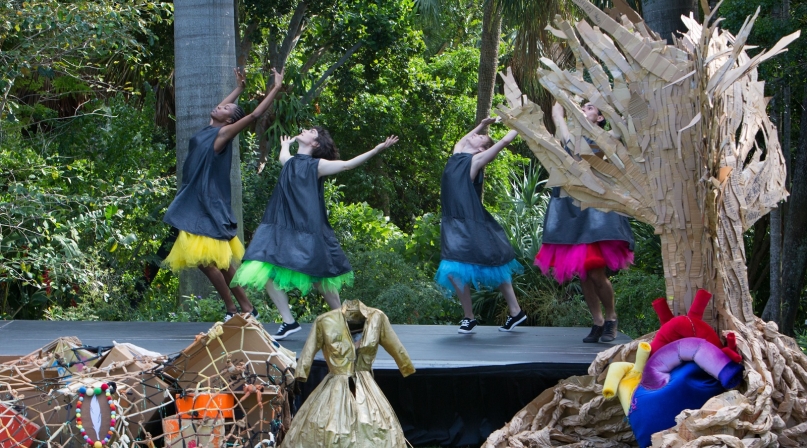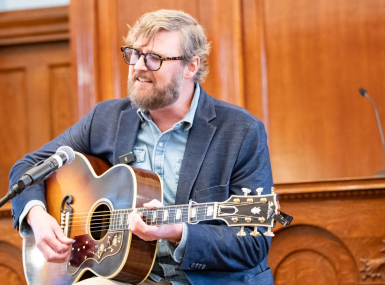Problem:
|
Finding ways to make the public more aware of the environment.
|
Solution:
|
Engage the arts community to help get the word out about the environment.
|
Miami-Dade County is collaborating with local artists to bring environmental awareness to the community through its Arts Resilient 305 program.
“Climate change, sea level rise, these kinds of issues are affecting literally the fate of the planet,” said Michael Spring, director of Miami-Dade County’s Department of Cultural Affairs.
“And I think one has to be alert to ways in which you can help formulate solutions and ways to address things that threaten the very survival of places, and the arts community is filled with creative-thinking people who are great at collaborating with everyone from technology to the sciences, to all kinds of endeavors in a community to address solutions,” he said.
Learn more
Miami-Dade County’s Arts Resiliant 305 program won a 2022 NACo Achievement Award in the Arts, Culture and Historic Preservation category.
Nominate your county's programs for Achievement Awards through April 14
“The arts are no longer looked at as just being a nice thing to have because they provide a great quality of life — even though they do that — but they’re increasingly being looked at as part of the solution for addressing key community issues,” he noted.
Miami-Dade County’s Department of Cultural Affairs has a citizen advisory board whose members are selected by elected officials. According to Spring, the chair of the board traditionally has a background in business or civic leadership, but for the first time ever, it was an artist — Xavier Cortado — whose work largely focuses on climate change. Cortado challenged the department to mobilize the arts community around the environment and develop what ultimately turned into the Arts Resilient 305 initiative.
“To some degree, our entire county began to look at its budget through the lens of resiliency and green practices, so there was this sense of this being a priority,” Spring said. “I don’t think that our mayor and our elected officials immediately thought that the Cultural Affairs Department would have a role in this, but we did — we immediately thought that this could be an area for our involvement, so we looked around to see what other people were doing, figuring why invent something if somebody else was already doing it well?
“And oddly enough, we couldn't find anything — I mean, there were some initiatives in Europe that were going on, in Great Britain, in regard to the arts community being active in the issues of the environment and resiliency, but we really couldn’t find anything very comprehensive about this, so that’s when we put our heads together and we began to work on this with the cultural community,” he said.
The department works with thousands of artists and more than 500 art organizations, so it convened a series of roundtables to share best practices for the creation of art in sustainability, related to conservation of energy and water, as well as discover the level of environment-focused work already being done in the community to connect them to grant funding. A survey they conducted found that out of the roughly 220 responses, around half were already doing work related to the environment and were interested in getting more involved with it, according to Spring.
“One of the obvious things we decided at the beginning was just to develop a graphics kit that arts groups and artists could use and plug into their work that provided more factual information about things you could do to be helpful in this area, but we also periodically send out Arts Resilient 305 e-blasts to artists and arts organizations that provides them with information about opportunities, because everybody’s always looking for funding for things or people to collaborate with, and so our resiliency office is really great about this, because now their antennas are up about opportunities for nonprofits to work with governments or to work with other businesses, and whenever they find things they send them to us, and then we send them out to artists and arts organizations, so they can take advantage of the resources that are necessary to power this forward,” Spring said.
The Arts Resilient 305 program initially functioned through a grant from the National Endowment for the Arts and now receives funding through the county.
“Often with new programs, I get the attention of the county budget folks by pulling in some outside funding,” Spring said. “It ends up being like the Good Housekeeping seal of approval, like, ‘OK, somebody's taking you seriously because a lot of these ideas are not very conventional and you have to sell them a bit get spending money on them, so the National Endowment for the Arts grant really helped with that, as it’s helped with other programs that we pioneered here in the past.”
Spring encouraged county governments to not underestimate utilizing the arts as a driver for progress in a number of areas, from environmental awareness to economic mobility.
“I often say to our elected officials here, because we have such great examples of it, that if you want to figure out a way to revitalize a neighborhood, put a theater in it,” Spring said. “We have the annual Art Basel Art Fair here in Miami in December of every year, and I talk to them about, ‘If you ever doubted the fact that the arts contribute to the economy, try to get a restaurant reservation or rent a car or find a hotel room during that arts week here in Miami.’
“And it’s not just for that one week, but it’s sort of a poster child for the power of the arts to address key issues, everything from economic development to climate change, so I think that these are important examples of how creative thinking can help address really key issues facing communities.
In 2022, Miami-Dade County Mayor Daniella Levine Cava and City of Miami Beach Mayor Dan Gelber worked together to bring the Aspen Ideas: Climate Summit to Miami and tasked the county’s Department of Cultural Affairs to commission 14 local artists to create visual, performing and media works during the conference as part of the Arts Resilient 305 initiative, Spring said.
Art showcased during the summit ranged from a choreographed dance ritual that aimed to “explore environmental racism as the root cause of generational gentrification, carbon footprint and water ethics” to the Plastocene Swim Line, a photography series that highlights the exploitation of fast fashion and consequences of consumer culture. It was such a success, Spring said, that the Aspen Institute is returning next month for its next summit.
“So, once again the county and the city of Miami Beach are collaborating on commissioning work from another dozen or so different artists, because we just have a wealth of creative people here to do these interventions around the themes of climate change and resiliency,” Spring said. “…I think that we have one of the most progressive mayors in America now in Daniella Levine Cava, and she has really focused our government on this issue and she’s encouraged our department’s work in this area.
“We have new positions in our government that focus on Biscayne Bay and on the effects of heat on people in businesses and communities, so this is in the context of a mayor who’s really leading the charge — she’s at the forefront of pointing the government in the direction of addressing these things, so the governmental environment around what we’re doing couldn’t be more supportive and this has a lot to do with a mayor who really gets it, who really understands that there’s no time to delay on looking at solutions to these things.”



